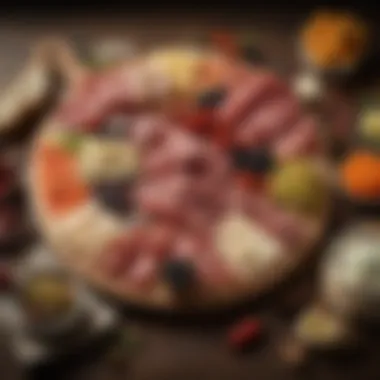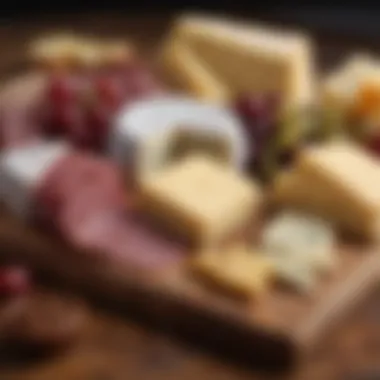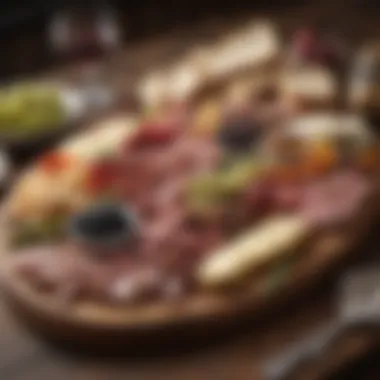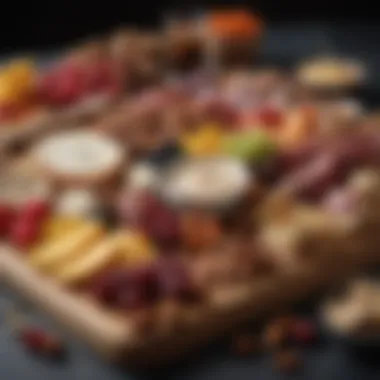The Ultimate Guide to Premade Charcuterie Boards


Intro
Premade charcuterie boards are more than just beautiful displays of food; they are a celebration of flavors, textures, and cultural traditions. These boards serve as both a gastronomical delight and an innovative way to entertain guests. This guide delves into the opportunity that premade charcuterie presents, emphasizing its advantages, essential components, and methods of preparation and presentation. We aim to provide a rich resource for culinary enthusiasts seeking to enhance their knowledge and skills.
Recipe Overview
Recipe Name
Premade Charcuterie Board
Description of the Dish
A premade charcuterie board is a visually striking assortment of cured meats, cheeses, fresh fruits, nuts, and various accompaniments assembled in an attractive manner. Each component is carefully selected to achieve a balance of taste, texture, and aesthetics. The premise is simple: to create a shareable platter that invites conversation and enhances the dining experience.
Ingredients
List of Ingredients with Measurements
- Cured Meats: Select 200-300 grams of a variety of meats such as prosciutto, salami, and chorizo.
- Cheeses: Choose 100-200 grams of different cheeses, like Brie, aged cheddar, and goat cheese.
- Fresh Fruits: Incorporate a mix of seasonal fruits, like figs, grapes, and berries.
- Nuts: Use about 100 grams of assorted nuts, such as almonds or walnuts.
- Crackers and Bread: Aim for 150 grams of a selection of artisan crackers and sliced baguette.
- Accompaniments: Optional items may include olive oil, honey, or a chutney; a couple of tablespoons of each is sufficient.
Special Notes on Ingredients
- Selecting high-quality cured meats and cheeses is essential; consider local options or artisan producers for the best flavors.
- For those with dietary restrictions, plant-based alternatives are available, such as almond cheese or tofu-based spreads.
- Pair ingredients based on flavors—sharp cheeses often contrast nicely with sweet fruits.
"A well-composed charcuterie board is akin to an artist's palette, where every item plays a role in a grander culinary narrative."
In summary, strategic selection and arrangement of ingredients result in a visually appealing and flavorful charcuterie board. Readers can elevate their culinary skills and impress their guests by mastering the art of creating these stunning boards.
Understanding Premade Charcuterie Boards
Premade charcuterie boards blend aesthetics and flavor, offering a delightful experience for gatherings or quiet evenings. Understanding this culinary phenomenon is crucial for anyone seeking to elevate their food presentation and enjoyment. The construction of these boards encompasses careful selection of ingredients and thoughtful assembly. This ensures that not only do they please the palate but also create an inviting visual appeal.
Definition and Origin
A charcuterie board consists of an assortment of cured meats, cheeses, fruits, nuts, and condiments, artfully arranged to create a balanced presentation. The term "charcuterie" comes from the French word for pork but has evolved to encompass a broader range of culinary presentations. Initially, charcuterie was primarily focused on preserving meats and was considered a practical solution for utilizing every part of the animal, especially in times of scarcity. Over time, it transformed into an art form, emphasizing presentation and flavor combinations. The trend of premade boards has gained popularity due to their convenience and visual appeal, making them a common choice at events and venues.
Cultural Significance
Charcuterie boards hold cultural significance in various social settings. They foster sharing and connection among people, making them ideal for gatherings. The act of selecting items, sharing stories about them, and enjoying them together creates a communal experience.
The significance of these boards varies across cultures. For instance, in Spain, a similar practice exists with tapas, small dishes enjoyed communally. In Italy, antipasto serves a similar function, showcasing cured meats and cheeses. These practices enrich social interactions, demonstrating that food can be a medium for connection and enjoyment.
In summary, understanding premade charcuterie boards reveals not only their culinary value but also their role in enhancing social experiences. Their history and cultural relevance underscore their importance in contemporary dining.
Components of Charcuterie Boards
Understanding the components of a charcuterie board is critical. Each element plays a specific role in the overall experience. From taste to aesthetics, the right combination enhances flavor and visual appeal. By carefully selecting ingredients, one can create a harmonious balance that delights the palate. This section will explore the various components that make up a premade charcuterie board, offering insights into their selection and arrangement.


Meats
Varieties of Cured Meats
Cured meats are central to any charcuterie board. Options like salami, prosciutto, and chorizo offer different flavors and textures. Salami provides a spicy kick, while prosciutto's thin slices offer a delicate taste. These varieties contribute to the richness of the board and draw in a wide array of taste preferences. The unique feature of cured meats lies in their preparation methods. They are often seasoned and air-dried, which intensifies flavor. However, one must be mindful of the sodium content in these meats, as some might find them too salty.
Choosing Quality Meats
Selecting quality meats is crucial for success. Opting for artisanal or locally sourced products proves beneficial. These meats often use traditional curing methods, which result in superior flavor. Additionally, fresh meats contribute to a more enjoyable eating experience. Look for meats with natural ingredients and limited preservatives. Be aware, however, that quality meats might come with a higher price tag, but they justify the cost with their taste and overall impact.
Cheeses
Hard versus Soft Cheeses
The choice between hard and soft cheeses greatly influences the board. Hard cheeses like Parmigiano-Reggiano provide a nutty flavor, while soft cheeses such as Brie or goat cheese add creaminess. This variety contributes to a well-rounded tasting experience. The contrast between textures also balances the heaviness of cured meats. However, the downside is that some individuals may have preferences leaning toward one type over the other. By incorporating a mix, you cater to diverse tastes.
Pairing Suggestions
Pairing cheeses with meats and accompaniments enhances the flavor profiles. For instance, pairing sharp cheddar with spicy chorizo creates a delightful contrast. Fruit compotes or honey add sweetness that complements both cheeses and meats. The unique aspect of pairing lies in the endless possibilities. Experimenting with various combinations allows for a personalized touch. However, it is essential to balance flavors without overpowering one another, which may require some practice.
Accompaniments
Nuts
Nuts provide a satisfying crunch and are a popular addition to charcuterie boards. Varieties like almonds, walnuts, and pistachios enrich the flavor profile. They also offer healthy fats, making them a nutritious option. Their savory notes can offset the richness of meats and cheeses. However, some guests may have nut allergies, so it is wise to provide alternatives or label items clearly.
Fruits and Vegetables
Including fresh fruits and vegetables adds color and freshness. Grapes, figs, and carrots can complement the savory components. These elements also bring a refreshing contrast to richness, enhancing overall enjoyment. Notably, fruits can assist in cleansing the palate between bites. On the downside, freshness may require more attention in storage and presentation. Subpar produce can detract from the board's overall appeal.
Spreads and Condiments
Spreads and condiments bring diverse flavors to the table. Options like mustard, honey, or fig jam can enhance the overall taste experience. They provide additional dimensions that pair well with both meats and cheeses. The key characteristic of spreads is their versatility; they can be sweet or savory. However, overdoing condiments may overwhelm delicate flavors of the cheeses and meats. A balanced approach ensures that all elements shine.
Overall, the composition of a charcuterie board is not just about filling space. It is about creating a beautiful and delicious experience. By carefully selecting each component, one can elevate an ordinary gathering into something remarkable.
Creating the Perfect Premade Charcuterie Board
Creating a perfect premade charcuterie board is crucial for any gathering. It transcends mere food preparation; it reflects thoughtfulness and understanding of flavors. The arrangement of a charcuterie board can enhance the enjoyment of its components, making it important to consider several factors in its creation. Each element needs to shine on its own while also contributing to a cohesive whole. By understanding how to source ingredients, assemble them strategically, and present them effectively, one can elevate the experience of enjoying a charcuterie board.
Sourcing Ingredients
Local Delis and Markets
Local delis and markets offer a rich variety of fresh and authentic ingredients. These venues emphasize quality and locality, helping consumers discover unique flavors that mass-produced supermarkets might lack. A key characteristic of local delis is their emphasis on artisanal products. Sourcing from these places not only supports local businesses but often leads to higher-quality meats and cheeses.
A unique feature of local delis is the knowledgeable staff. They can provide recommendations tailored to personal tastes or dietary needs. However, the disadvantages of local sourcing may include limited availability or higher prices, especially in urban areas. Nonetheless, the benefits often outweigh these drawbacks, as the quality of ingredients can significantly impact the final presentation and taste of the board.
Online Options


Online options for sourcing charcuterie ingredients have become increasingly popular. Accessibility is one key characteristic of this approach. Consumers can easily browse a wide selection from various producers without geographical limitations. Many online retailers specialize in gourmet ingredients, providing options that may not be available locally.
A unique advantage of online sourcing is the ability to read reviews and compare products in detail. However, this method has disadvantages, such as potential shipping delays or the challenge of sourcing fresh ingredients. Additionally, there is a risk of not receiving products that match expectations when viewed online. Balancing the convenience of online options with the assurance of quality can influence overall satisfaction when creating a charcuterie board.
Assembling the Board
Layout Strategies
Layout strategies play a pivotal role in creating an appealing charcuterie board. A pleasing arrangement not only enhances visual aesthetics but also promotes better flow during serving. Using larger items, such as cheese wheels, as anchors can create focal points around which smaller elements are distributed.
An effective layout can highlight contrasting colors and textures, making the board more enticing. Key characteristics of successful layout strategies include creating visual balance and ensuring that all components are easily accessible. However, it requires consideration and planning. Poor layout can lead to overcrowding on the board, making it overwhelming and less enjoyable.
Balance and Color Considerations
Balance and color considerations are critical for the perception of the charcuterie board. Each component's color and texture influence visual appeal, while balance ensures a harmonious distribution of flavors. Incorporating a variety of colors—reds from meats, yellows from cheeses, and greens from accompaniments—can create an inviting atmosphere.
The unique aspect here is how balance contributes not just to aesthetics, but also to taste. Ensuring that no single flavor overpowers others encourages exploration of different combinations. A disadvantage to consider is that achieving perfect balance can be subjective, varying from one person to another. Striking a good compromise will elevate the board's overall appeal.
Presentation Techniques
Serving Additions
Serving additions can significantly enhance the overall experience of enjoying a charcuterie board. Items such as small bowls for dips or spreads add functionality while also serving as visual breaks between groups of ingredients. These additions can offer unique flavors that complement the main components.
A key characteristic of serving additions is their ability to introduce flavor contrasts and enhance interactivity. However, they can also clutter the board if not used wisely. Careful consideration of spacing and size of serving additions is essential to maintain an appealing presentation that remains practical for the guests.
Importance of Utensils
The importance of utensils in creating a charcuterie board cannot be overstated. Proper utensils enhance the serving experience and can influence how guests interact with the board. Providing the right tools, such as cheese knives and small forks, is vital for taste and ease of access.
Key aspects of utensils include how they can facilitate tasting different components without cross-contamination. However, having too many utensils can lead to confusion on how to serve items properly. Ensuring that the board is well-equipped with necessary, yet minimal, tools is ideal for smooth enjoyment and sharing.
Dietary Considerations
Dietary considerations play a vital role when preparing and selecting premade charcuterie boards. This focus ensures that everyone, regardless of dietary restrictions or preferences, can enjoy a well-crafted platter. Understanding various dietary needs, such as vegetarian, vegan, and gluten-free options, enhances the accessibility and enjoyment of these boards.
Offering alternatives not only meets the demands of diverse palates but also allows for unique flavors to emerge. This section will explore specific alternatives that cater to different diets while still maintaining the integrity and quality of the overall charcuterie experience.
Vegetarian and Vegan Alternatives
Substitutes for Meats and Cheeses
Substitutes for meats and cheeses are essential for creating inclusive charcuterie boards. These alternatives include various plant-based products that can mimic the textures and flavors of their animal-based counterparts. Popular substitutes often consist of items like marinated tofu, seitan, and nut-based cheeses.
The key characteristic of these substitutes is their ability to deliver satisfying taste and texture while catering to dietary preferences. These options are increasingly beneficial as more people adopt vegetarian or vegan lifestyles. Unique features, such as the variety of flavors available—from smoky to spicy—enhance their appeal. However, some may find plant-based meats can be less savory than traditional options, which could result in some trial and error to find suitable pairings with other accompaniments.
Enhancing Flavors Without Animal Products
Enhancing flavors without animal products is not just a creative challenge but an opportunity to explore a plethora of plant-based ingredients. Utilizing herbs, spices, and marinades can elevate the taste profile of vegetarian and vegan selections. Fresh herbs like basil, dill, and cilantro can significantly enhance the overall flavor experience.


The main advantage here lies in the ability to create vibrant, flavorful selections while avoiding animal products. This not only aligns with ethical considerations but also introduces diverse flavor profiles that might have been overlooked. The unique feature is the balance of taste, making sure that while avoiding animal products, the board remains delicious and visually appealing. A disadvantage may be the perception that meals without animal ingredients lack richness, but with the right combinations, this perception can be altered.
Gluten-Free Options
Gluten-free options are increasingly essential in the modern culinary landscape. Many people are discovering gluten intolerance or celiac disease, making it crucial to include suitable choices on charcuterie boards. Many naturally gluten-free foods such as fruits, vegetables, and certain nuts serve as excellent options.
When preparing a gluten-free charcuterie board, it is important to ensure that all components, including dips and crackers, are labeled gluten-free. This attention to detail enhances safety for those with dietary restrictions while ensuring enjoyment for all diners. Key characteristics of gluten-free options include a focus on whole foods and quality ingredients, often leading to fresh flavors and textures that many appreciate.
Trends and Innovations in Charcuterie
Charcuterie boards are not just a culinary trend but also an art form that has gained momentum and innovation over recent years. Understanding this evolution is crucial in appreciating the many possibilities these boards offer. The prominence of charcuterie lies in its ability to merge various flavors, textures, and visual appeal while fostering social interaction. As culinary enthusiasts seek unique experiences, the need to adapt and innovate within this sphere becomes increasingly evident.
Charcuterie Boards as Experiences
Themed Boards
Themed charcuterie boards have emerged as a popular choice among hosts and event planners. These boards revolve around a unifying concept, such as seasonal themes, specific cuisines, or even movies. Such a focus allows for a curated selection of meats, cheeses, and accompaniments that align with the chosen theme. This distinctive approach contributes significantly to the overall experience of sharing food, elevating the typical charcuterie presentation into something more engaging.
The key characteristic of themed boards is their coherent presentation. Each element reflects the theme, creating an immersive experience. For example, a Mediterranean-themed board might feature olives, feta, and pita alongside cured meats and a range of spreads. This intentionality not only piques interest but also provides context, encouraging discussions among guests.
However, while themed boards present clear advantages, they may also limit creativity. Specific components must fit within the theme, which can constrain choices. Balancing theme adherence while still offering diversity is essential for success.
Interactive Elements
Another notable aspect of modern charcuterie boards is the introduction of interactive elements. These features engage diners beyond mere tasting. Options like DIY builds, where guests assemble their own bites or pair selections according to preference, create a memorable experience. This enhances the social aspect of food sharing and encourages experimentation with flavors.
The interactive characteristic of these boards makes them highly appealing. They allow individuals to engage with their food actively, fostering discussion and participation. An interactive board can feature various dipping sauces, assorted toppings, or even culinary stations where people can prepare their selections. Such options can amplify guest involvement, making the meal more of a communal affair.
On the downside, interactive elements can complicate logistics. Higher preparation efforts are required and additional equipment may be needed to facilitate the experience. Clarity in presentation is vital; otherwise, it could lead to confusion among guests.
Charcuterie in Different Cultures
Charcuterie varies greatly across different cultures, reflecting local flavors and traditions. This expansion of charcuterie practices allows for an enriched understanding of its place in global cuisine. Each culture offers its twist on the traditional board, incorporating locally available ingredients and techniques. This diversity is not only fascinating but also enriches one’s palate.
Researching these variations can inspire creativity when crafting your own charcuterie board. Engaging with global practices opens up new flavor profiles and combinations that might otherwise be overlooked. Such exploration enhances appreciation for charcuterie as a versatile concept, transcending geographical boundaries.
The End
The importance of the conclusion in an article about premade charcuterie boards cannot be overstated. This section serves as a pivotal recap of the essential elements discussed throughout the narrative. It emphasizes the value of understanding the components, assembly techniques, and presentation strategies for charcuterie boards. A well-crafted conclusion facilitates the reader's retention of information and reinforces key points.
As the article has shown, the art of charcuterie is more than just serving food; it is about curating an experience. The future of charcuterie boards appears promising, with trends indicating a shift towards personalization and creativity. This emerging focus enhances the appeal of charcuterie boards, making them a popular choice for gatherings and celebrations.
This guide also highlights the benefits of catering to various dietary needs, widening the audience for charcuterie boards. Whether one is crafting a board for an intimate dinner or a grand celebration, understanding how to accommodate different preferences can elevate the dining experience.
In summary, the conclusion reiterates the significance of premade charcuterie boards in culinary culture today. It encourages readers to explore their creativity when crafting their own boards, leveraging the insights shared throughout this guide. By fostering an appreciation for quality ingredients and diverse pairings, this article aims to inspire food lovers of all ages to delve into this culinary art.
The Future of Charcuterie Boards
Looking ahead, the future of charcuterie boards holds exciting possibilities. Innovation in food presentation is on the rise. This means that charcuterie boards are likely to evolve, integrating new ingredients and themes. Both visual appeal and taste are critical in this evolution.
- New Ingredients: Expect to see more exotic and regional ingredients making their way onto boards. This could include things like pickled vegetables, infused oils, and artisanal cheeses from local producers.
- Themed Boards: Themed charcuterie boards are growing popular. Themes can vary widely—ranging from seasonal offerings to regional flavors. These themed boards can add a unique twist to gatherings.
- Interactive Experiences: Charcuterie boards are also likely to incorporate interactive elements. This might involve activities where guests can assemble their own portions, personalizing their eating experience.
"A charcuterie board is not just a dish; it is an experience that can reflect the essence of the occasion."
The emphasis on sustainability may also increase. Consumers are looking for eco-friendly choices. Sourcing local and organic ingredients will likely further shape this culinary trend.







